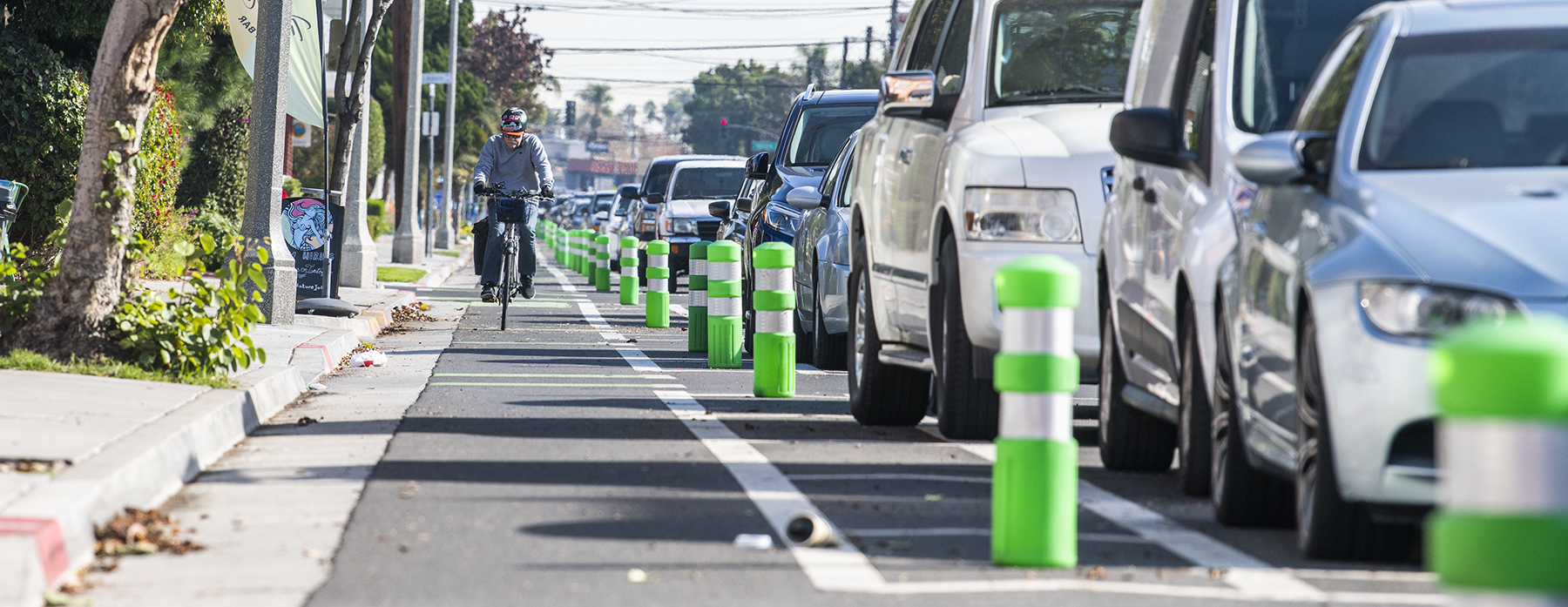
Work continues on Vision Zero, Long Beach’s plan to eliminate fatal traffic accidents by 2026—and forthcoming improvements to the city’s bike infrastructure, officials say, will help achieve that goal.
City Traffic Engineer Carl Hickman laid out a series of projects that will improve the city’s bike network during Tuesday’s City Council meeting. The projects ranged from a series of curb extensions and pedestrian medians at intersections throughout Downtown Long Beach to a separated bike lane on Del Amo Boulevard between Atlantic Avenue and Orange Avenue—and council members also had their own ideas for increasing bike safety.
The plan in Downtown aims to improve visibility and safety for bike and pedestrian traffic. Approximately 190 extensions and medians are planned to be completed by 2025 between Magnolia Avenue, Alamitos Avenue, Seventh Street and Ocean Boulevard, Hickman said, for an estimated $8.8 million, funded through a grant from the Caltrans Active Transportation Program.
Hickman also presented plans for a cycle track on Pacific Avenue from Ocean Boulevard to Pacific Coast Highway, which also has a projected 2025 completion date. The project will include bus islands and a separated bike lane, and will shorten the length of pedestrian crossings. The Caltrans Active Transportation Program is also funding this $8.3 million project.
And a separated bike is also coming to Del Amo Boulevard between Atlantic Avenue and Orange Avenue, which will connect their respective bike paths. To separate the lane, a flat, elevated curb will serve as a border between vehicular and bicycle traffic. Unlike the previous projects, this will be funded by local transportation return funds. Officials did not say how much it would cost.
Hickman also described a project to create a “bike boulevard”—a path with low motorized traffic designed to prioritize bike travel—on Pine Avenue between Eighth Street and Willow Street. This path would connect Downtown Long Beach to the Willow Street Metro Station and would encourage bike travel through “traffic calming” features including vehicle diverters, raised intersections and traffic circles. This path is also set to wrap up in 2025, and is funded with $4.4 million from the same Caltrans Active Transportation Program.
That proposal, though, came with some resistance, with local resident Senay Kenfe arguing in public comment that the boulevard would be detrimental to those living in the neighborhood where the boulevard would be installed due to the removal of parking for adjacent complexes.
And council members had their own concerns, which tended to follow three themes: connectivity, consistency, and the use of bollards.
Several council members questioned the connectivity of West Long Beach to other parts of the city, gravitating towards the Santa Fe Corridor as a potential place of focus.
“Our neighborhoods are great,” Councilmember Rex Richardson said. “It’s the corridors that lack attention.”
Councilmember Suely Saro, meanwhile, commented on the importance of being connected with the Los Angeles River, while Councilmember Al Austin emphasized the need to keep paths to schools safe and connected for kids.
“One big priority that we should not lose focus of is the safety of our children,” Austin said. “We should put them first.”
Another topic was the consistency of safety and aesthetics throughout a bike path. Several council members noted that many bike paths need maintenance in several areas to remain consistent with the new paths, and emphasized the importance of keeping a bike lane safe through its entirety.
Finally, several members of the council who have bike lanes with bollards—temporary vertical posts that are used to separate bikes from vehicles on the road—wondered what they might be replaced with. Hickman explained that while separated bike lanes is the overall goal, the use of vertical, concrete posts would be considered as replacements.
Hickman, though, also spoke to the bigger picture of bike infrastructure in Long Beach. He said the growth of the city’s BikeShare program is encouraging, and progress on the development of Long Beach’s bikeway has been steady.
After starting in 2016 and reaching around 30,000 members by 2018, Long Beach’s BikeShare program had 46,112 active members in 2020 and grew that number to 58,338 in 2021.
This success prompted the city to not only renew its operations and maintenance contract for the program for another two and a half years, Hickman said, but also to make plans for growth in 2022. Starting in May, the expansion will see 100-150 new electric bikes and over 800 refurbished non-electric bicycles, along with 50-75 new bicycle racks around the city to accommodate them.
As for bike paths,165 of the 300 miles of bike lanes set as a 2040 goal by the Bicycle Master Plan have been completed, according to Hickman. Looking ahead, this would require an average of 8 miles of additional bike lane constructed per year, a far cry from the under 2 miles completed in 2021, but it’s a goal the city will nonetheless meet over the next several years based on its plans.
Overall, Hickman said the city’s big picture plans—which include the 2017 Bicycle Master Plan and the 2020 Safe Streets Long Beach Initiative—have helped guide the city to where it is now and will continue to be critical in the years ahead.
Those plans have “really helped ground us and provide critical data to recommend projects,” he said, “and seek funding.”
